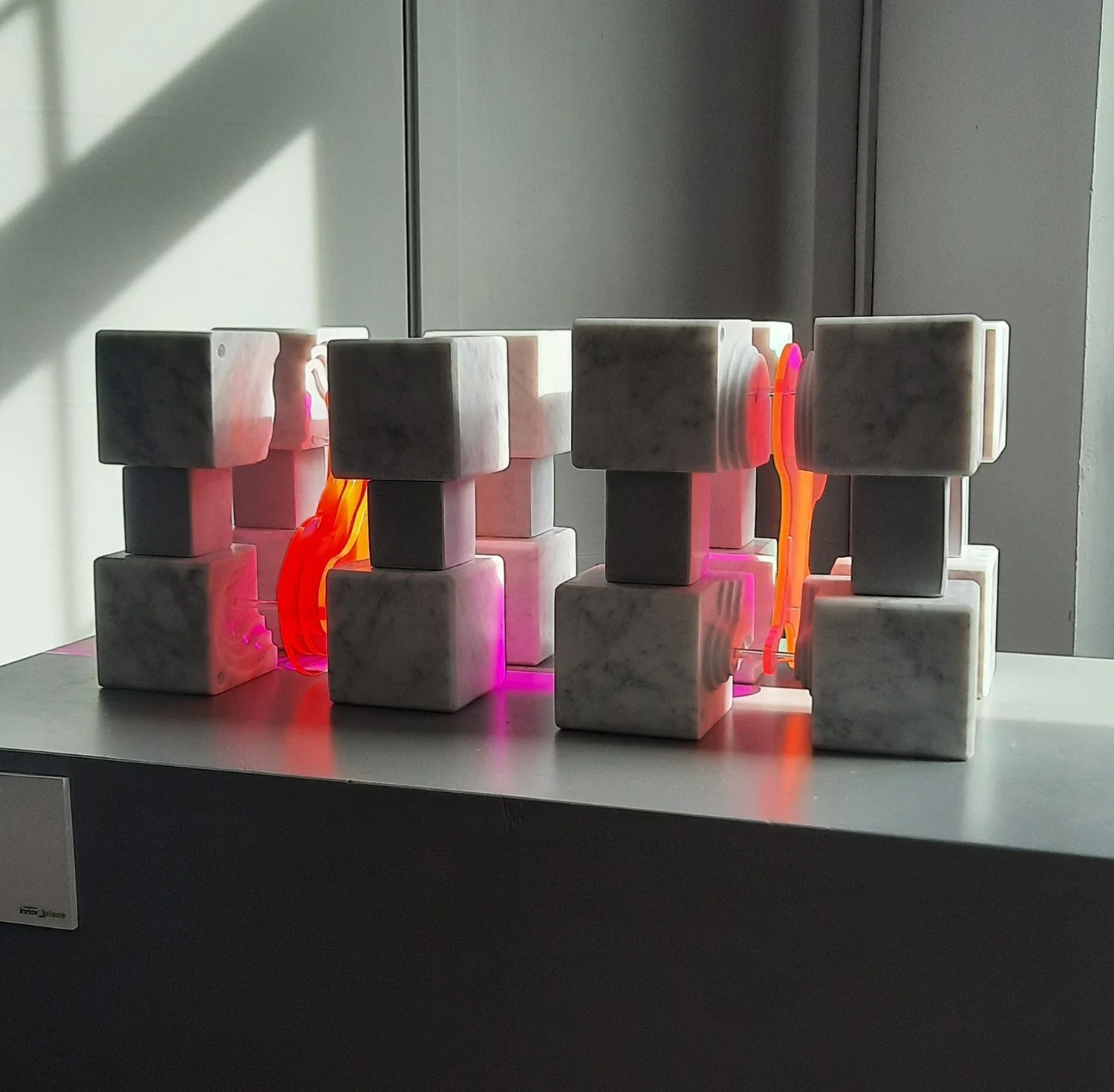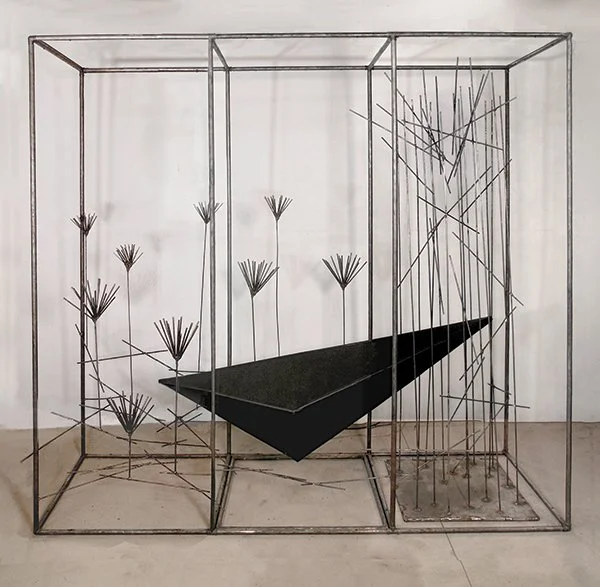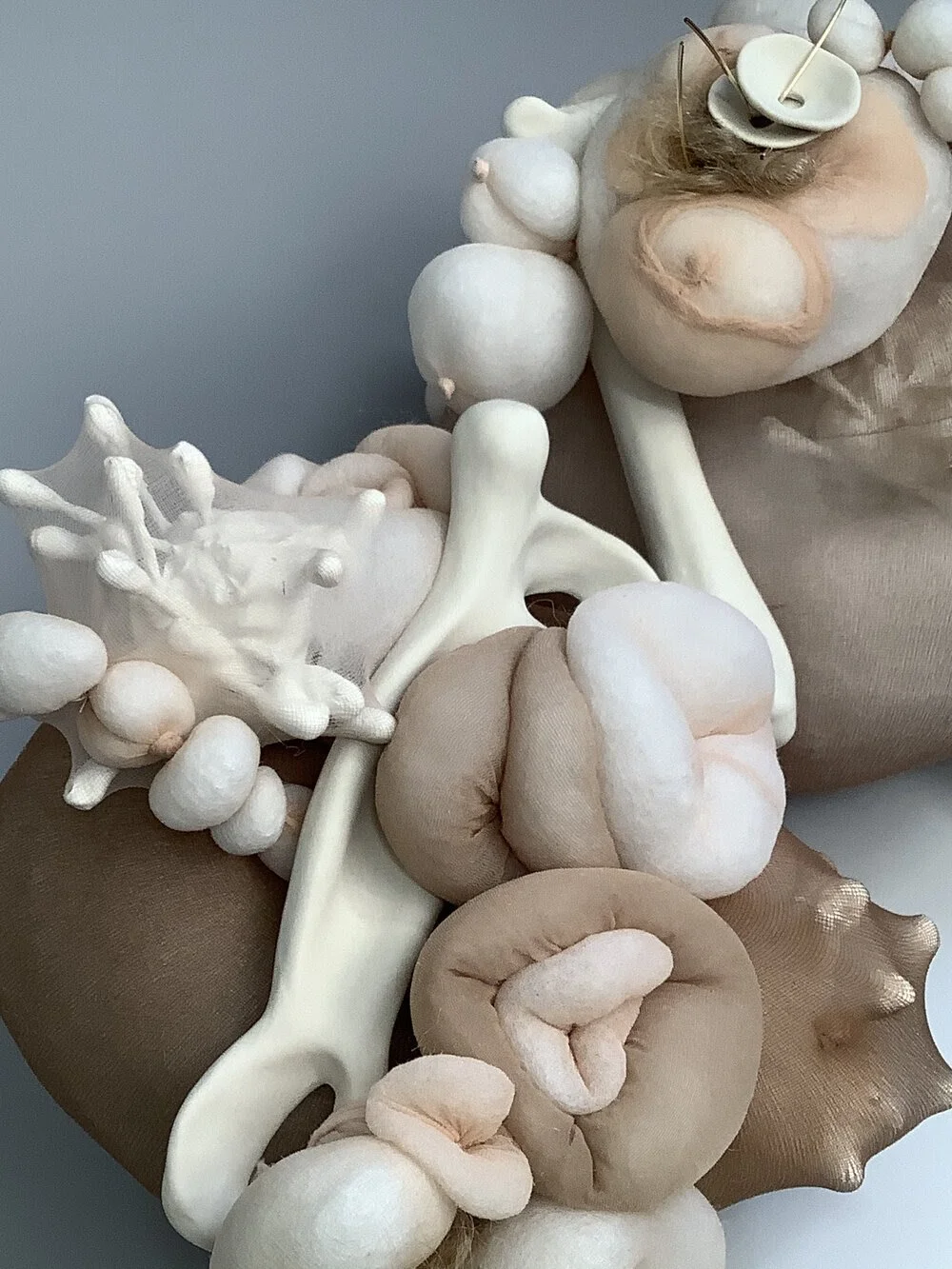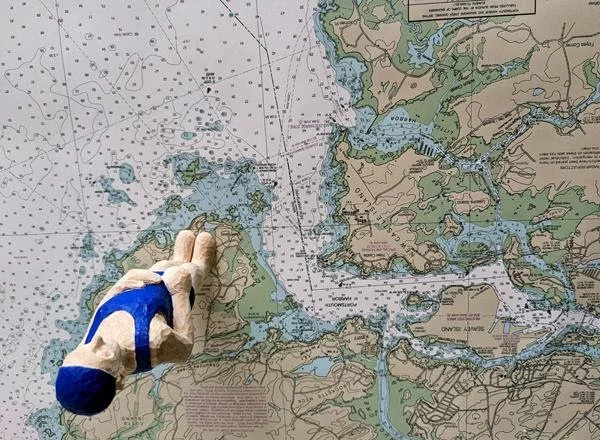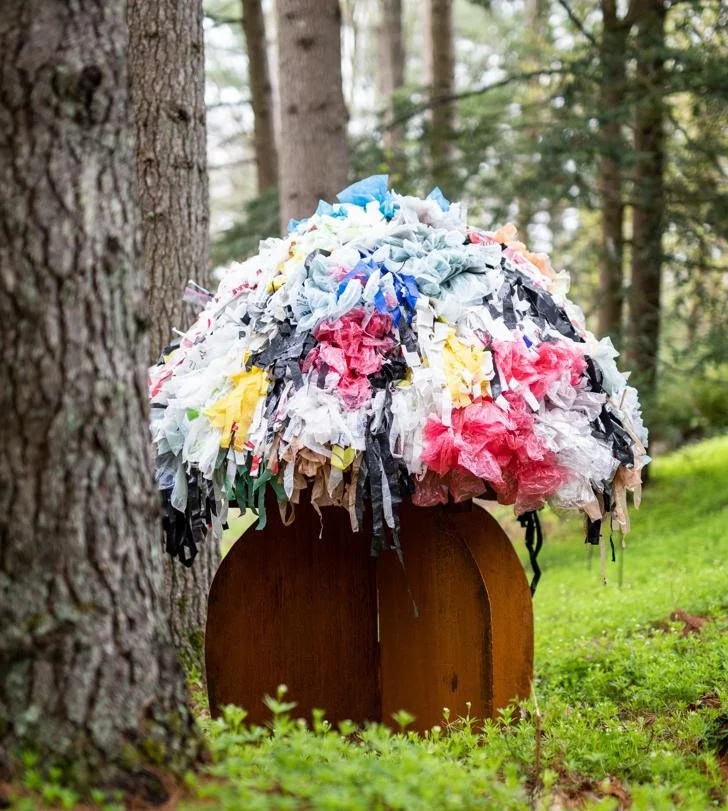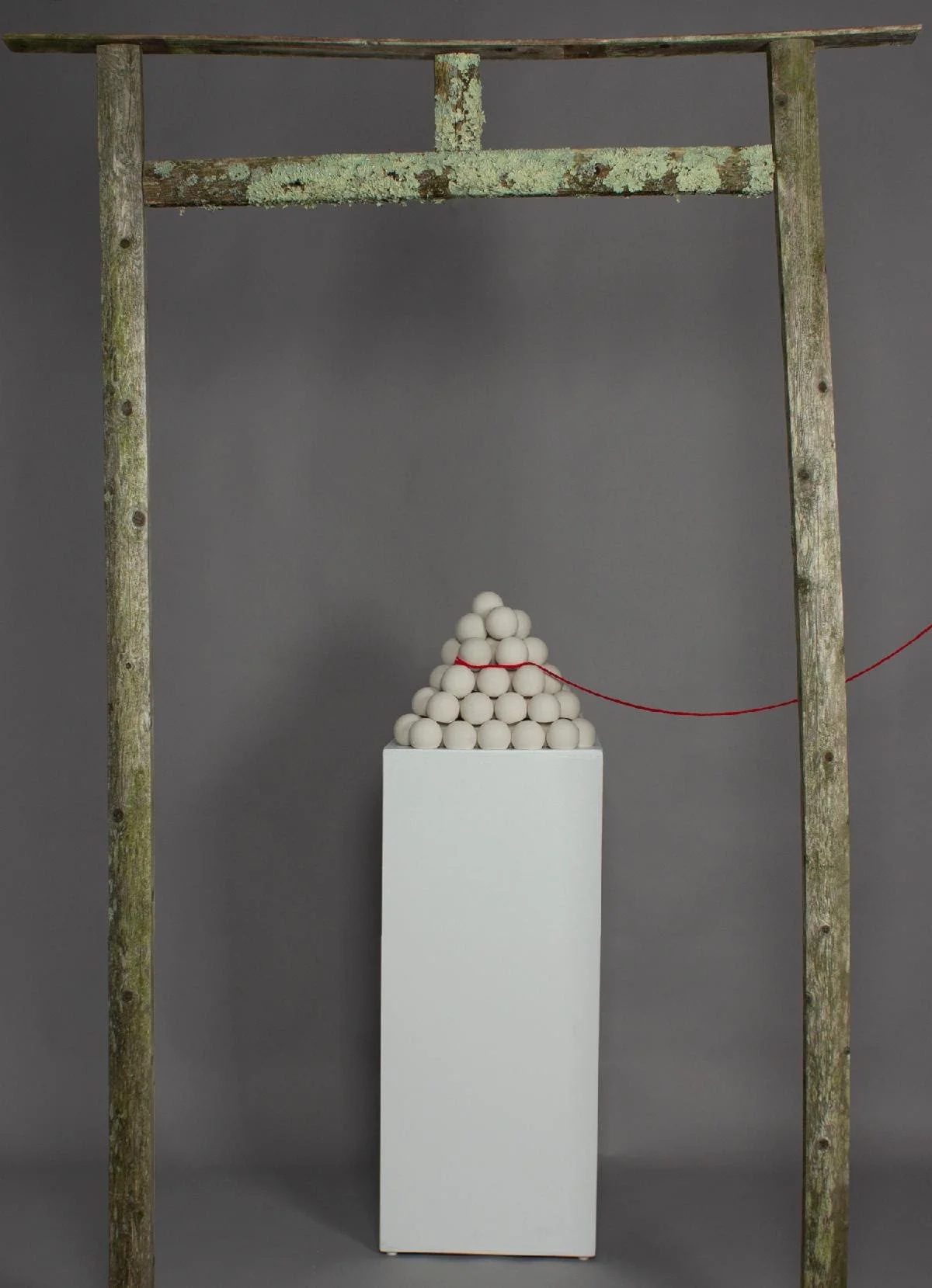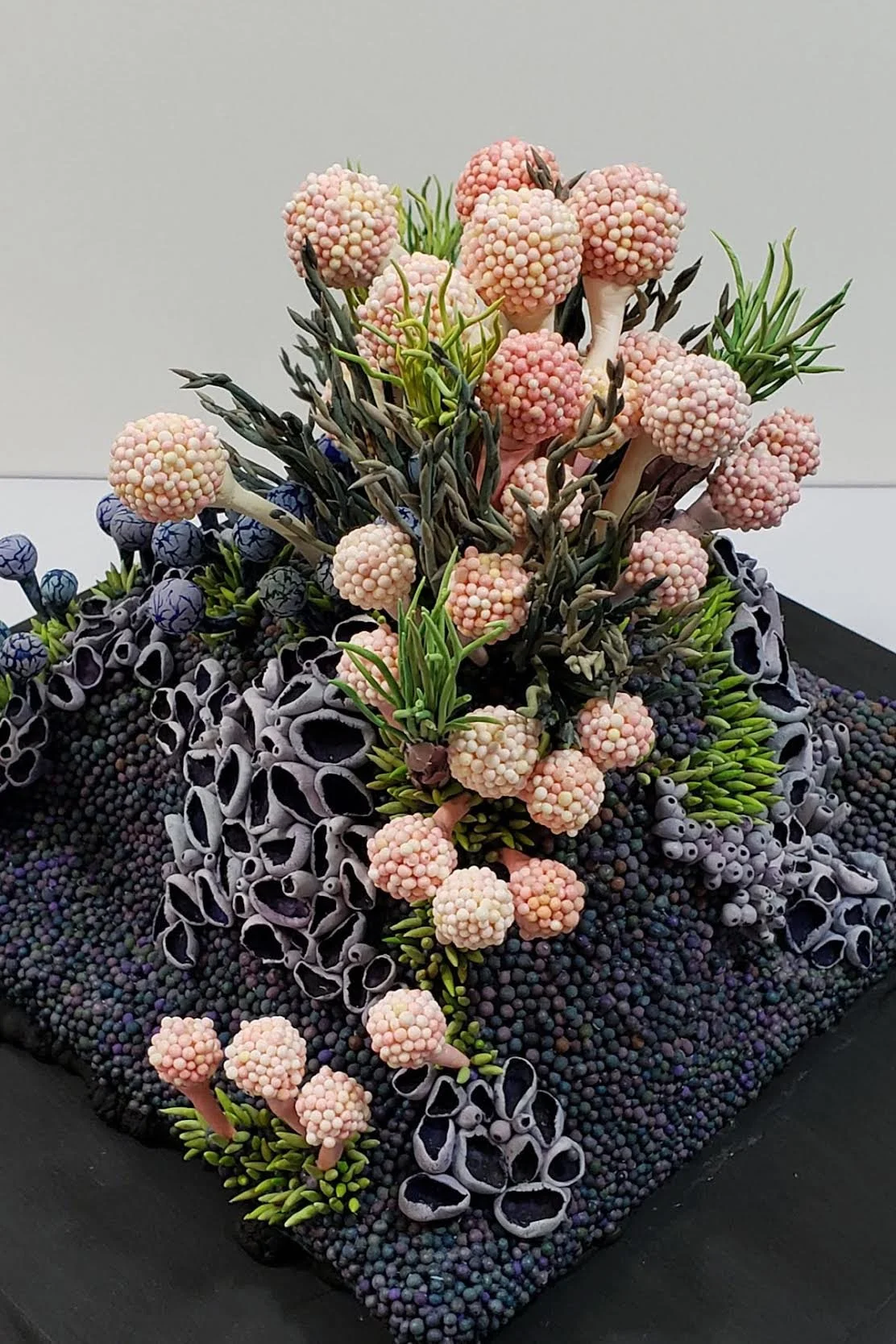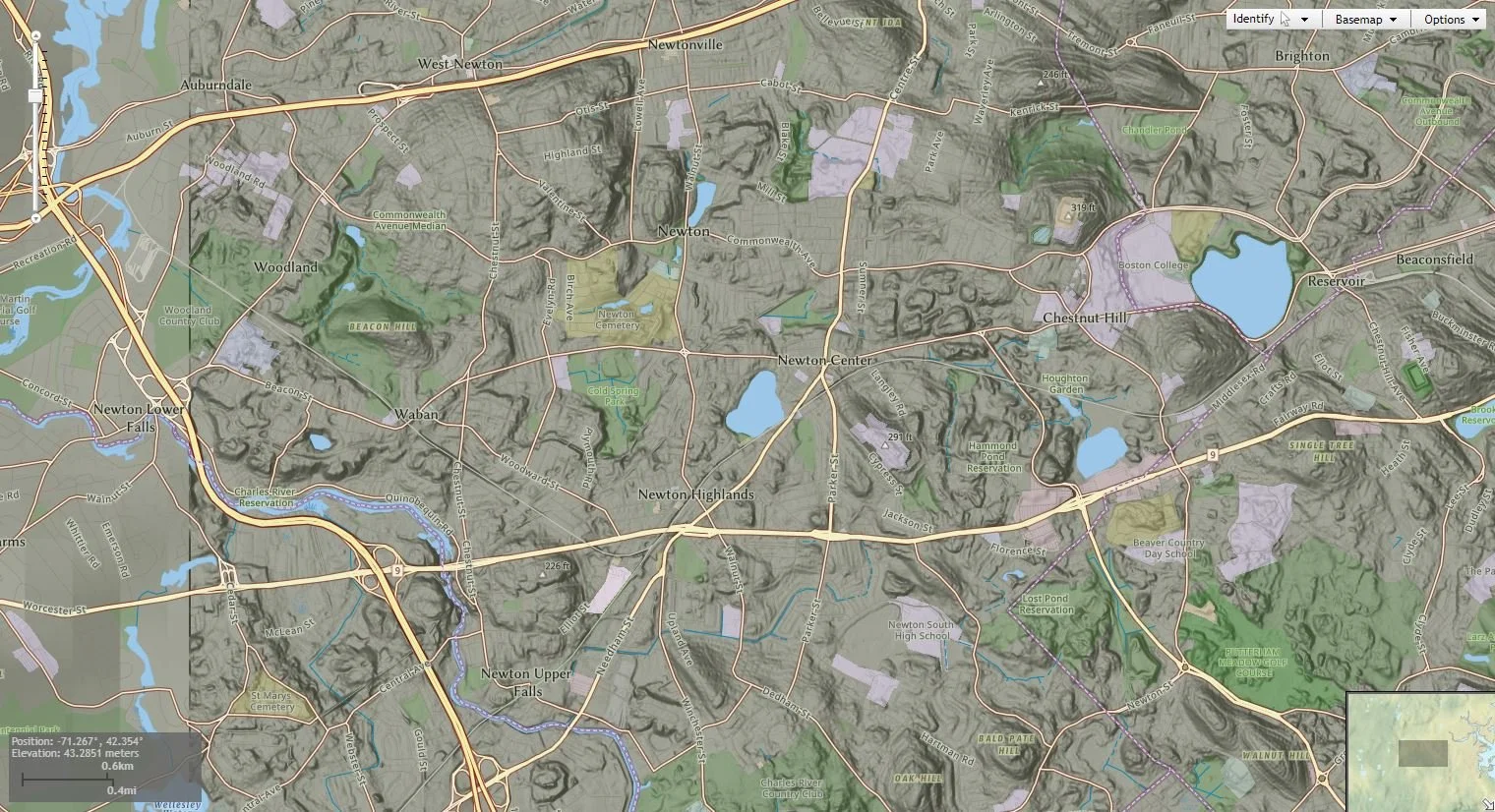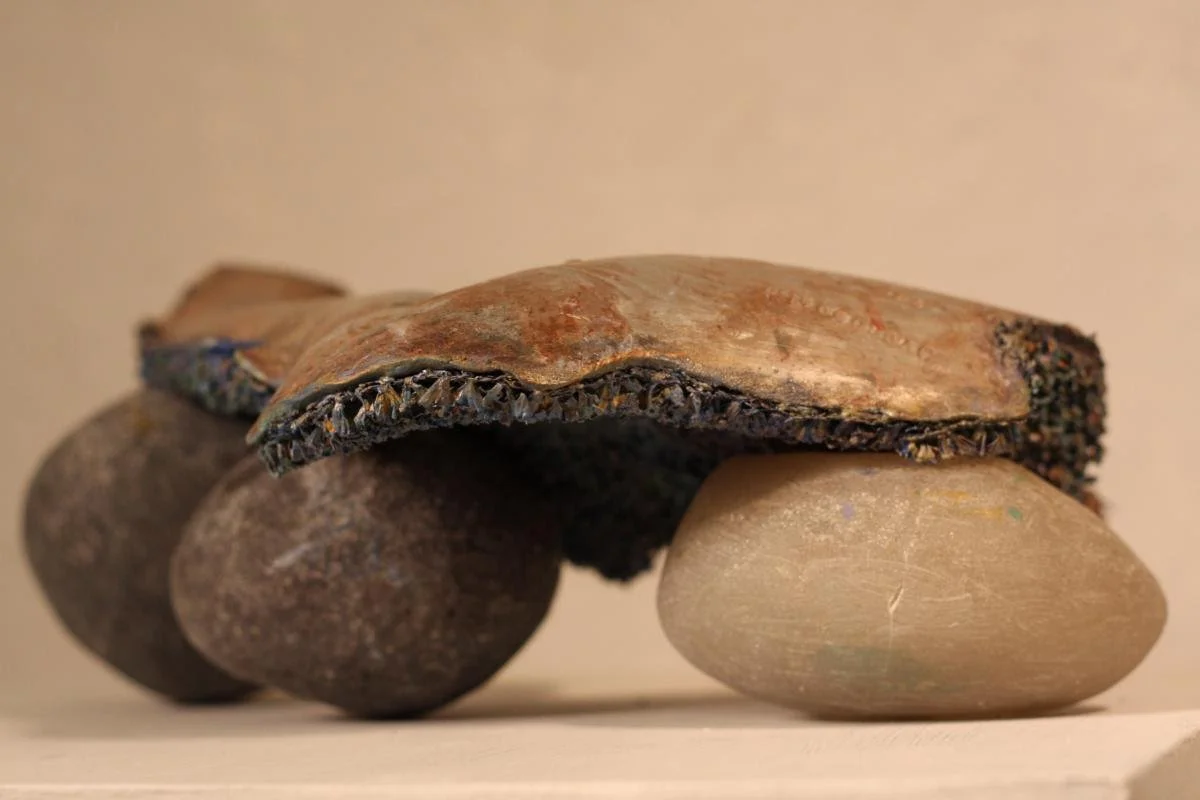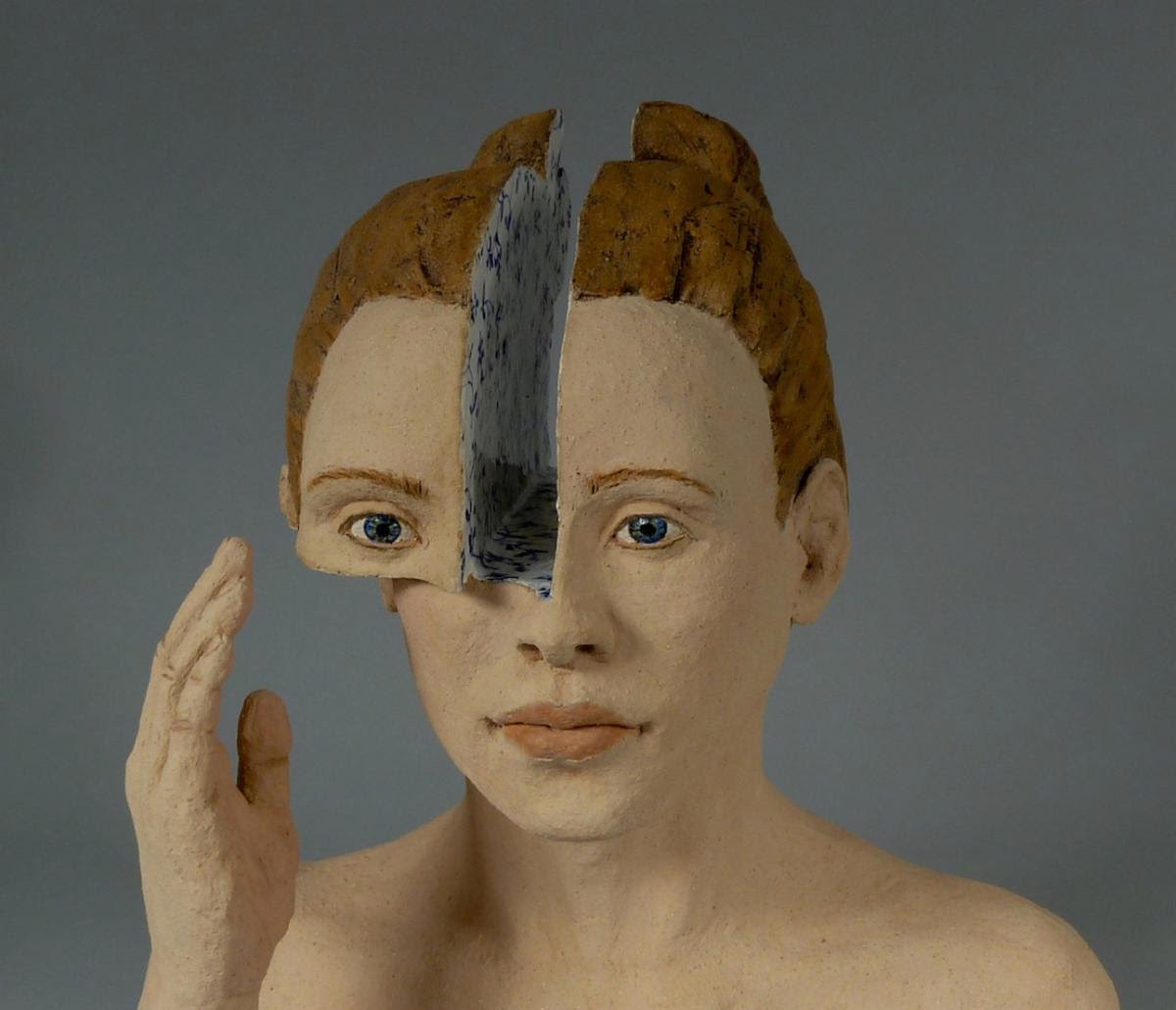
His ‘Proof of Life’
From Dennis Svoronos’s show “Proof of Life,’’ at Boston Sculptors Gallery, through Dec. 7
The gallery says:
“Years after his brain-cancer diagnosis, Dennis Svoronos remains surprisingly alive, and ponders the problems he and others face being among the masses of life-long patients. Through interactive and kinetic work, he conveys the horror and humor of the place between chronically ill and unexpectedly well.
“To these ends, Svoronos has made work with thousands of replicated medications, created eerie animatronics and uses brain-scanning technology in his own device called an MRI (Mind Reactive Instrument). As a patient himself, Svoronos uses his work to create a safe space to discuss and debate issues affecting our most vulnerable.’’
Setting forth
“Staggering” (mixed media), by Laura Evans, in her show “The Weight: how to move,’’ at Boston Sculptors Gallery.
Photo by Julia Featheringill
“When we have discovered a continent, or crossed a chain of mountains, it is only to find another ocean or another plain upon the further side. . . . O toiling hands of mortals! O wearied feet, traveling ye know not whither! Soon, soon, it seems to you, you must come forth on some conspicuous hilltop, and but a little way further, against the setting sun, descry the spires of El Dorado. Little do ye know your own blessedness; for to travel hopefully is a better thing than to arrive, and the true success is to labor.’’
— Robert Louis Stevenson (1850-1894)
‘Brief moments of clarity’
“Eco+Terrestre,’’ by Hillel O’Leary, at Boston Sculptors Gallery, through July 13.
The artist says:
“My sculpture, installation and public works are snapshot accretions capturing brief moments of clarity in a continuing process of navigating an increasingly turbulent world. They are an attempt to make meaning between the familiar and otherworldly, while provoking gut-feelings of tension, connection, loss, and wonder, through obfuscation, abstraction and interpretation of material history and culture. This work centers precarity as the coming state of everything, and with it, I hope to bring a level of urgency to a sense of self-reflection that is needed if we are to look beyond the way things have always been.’’
High-fiber art
“Experiment II,’’ by Anna Kristina Goransson, in her show “Topia,’’ at Boston Sculptors Gallery, through May 4.
The gallery says she is “a fiber sculptor working mostly with felted wool to create three-dimensional sculptures and installations. The process of taking fluffy wool fibers and creating a strong material that is light-weight and accepts dyes so well has intrigued her since she found this technique in 2004 during her MFA studies at UMass Dartmouth. Having always been a three-dimensional thinker, starting her career as a furniture maker educated at RISD, Kristina is drawn towards working things out sculpturally.’’
‘between hand-made and mass-Produced’
“Snulpture #4” (welded steel, fabric, audio and kinetic electronics), by Andrew Zimmerman, in his show “Snulpture,’’ at Boston Sculptors Gallery, opening April 3.
He says:
“In my work I am interested exploring the intersection between painting and sculpture, art and design, the hand-made and the mass-produced. I am excited by the tension that arises from situating my work in between these categories. I would like my paintings to create moments of unexpected discovery within a language of reconstructable forms.
“I fondly remember working with my dad in his wood shop as a young child. Cutting the parts and assembling the pieces into a bench or a table revealed to me a magical journey from a slab of wood to a finished product. More importantly, I experienced the joy and endless possibilities of making things by hand.’’
Inspired by Boston landmarks
"IYKYK" (wood, plastics), by Christopher Abrams, in his show "IYKYK," at Boston Sculptors Gallery, Oct. 3-Nov. 3.
The famous sign at Kenmore Square, in Boston.
The gallery says:
“The show is a series of small-scale sculpture based on iconic landmarks and forgotten histories in the Boston area. While Abrams continues to concentrate on small-scale representational concerns, the artist revisits and redirects his focus, abandoning the intense fealty to detail that characterizes his earlier miniature efforts, in favor of finding essential, meaningful symbols and imagery.
“Taking inspiration from his hometown, Abrams draws on the events and visual vocabulary that create and distinguish the unique identity of Greater Boston. Selecting and amplifying elements of the local, shared visual fabric, Abrams weighs how seemingly minor details can allude to a rich, shared narrative.’’
Wired for art
"Gail" (photogravure), by Liz Shepherd, in her show "Look Don't Look,'' at Boston Sculptors Gallery, through Sept. 29.
-- Image courtesy of the gallery
The gallery says the show features a collection of wearable wire sculptures “designed to both conceal and emphasize the person wearing them.’’ Artist Liz Shepherd invited 10 friends "of a certain age" to sit for portraits wearing the wire sculptures. “I wanted to see if their attitude about their appearance might be influenced by the experience of wearing an unusual, often flamboyant, object," she said. The exhibit also includes silkscreen images of the sculptures printed on mirrors so that visitors can view themselves through the lens of the artwork.
'Anatomy of the human soul'
Detail from “Meditation,’’ in Keri Straka’s show “Biological Tithing,’' at Boston Sculptors Gallery through July 14.
The gallery says:
The gallery says that ‘“Keri Straka: Biological Tithing’ combines textiles and ceramics to create clusters of cells, tissue, organs, and bones, while posing intimate questions about the anatomy of the human soul as witnessed by the aging human body. …Straka uses delicate, organic shapes created from fabrics and hard, striking ceramic accents to muse on the concept of tithing, wondering whether molted cells could be collected and used to patch and protect skin as it becomes threadbare with age or illness."
'Poignant reminders'
From Jessica Straus’s show “Packing for Mars,’’ at Boston Sculptors Gallery, through May 5. She grew up on New Hampshire’s seacoast.
The gallery explains:
“Black humor, longing, and regret are all at play in ‘Packing for Mars’ . Straus looks forward with dread to a future when humans must flee a devastated Earth to settle on far flung, arid worlds. Yet, the artist is not packing gear for survival in a desolate landscape but, rather, offering poignant reminders of what has been left behind. Masterfully carved wooden figures stand-in for everyman and everywoman as they gaze longingly earthward from the moon, Mars and the star fields. Fragile hand-sewn earth spheres reveal vulnerability in their delicate stitching. In a particularly poignant series, Straus whittles plant specimens from her native New Hampshire, transforming them from humble grasses into botanical treasures. ‘Packing for Mars’ looks both backward and forward in time, as we each contemplate the preciousness of the environment we love and on which we all depend.’’
To 'reinvigorate the landscape'
Work in Ana Flores’s show “Wood River,’’ at Boston Sculptors Gallery, through March 31.
The gallery says the show features sculpture from her “Sacred Grove’’ and “Cultivate’’ series, “celebrating our powers to rebuild and reinvigorate the landscape, and offering a glint of optimism in the face of our dangerous human default of destruction and deforestation. Flores lives at the edge of the forest by the Wood River in southern Rhode Island. Working manually on her land over the years, she feels the land also worked on her, reawakening a deep ‘sense of place.’ For Flores, the phrase is no longer metaphorical. The artist contends that her sense of place is just as real as her sense of smell or sight—a multi-sensory connection and understanding of not only the biological history of a place, but also of its layered human traces.’’
The Wood River watershed
Be like a mushroom
“Symbiosis,’’ by Natick, Mass.-based Rebecca McGee Tuck, in Boston Sculptors Gallery’s “Confluence’’ group show Feb. 1-Feb. 25.
The gallery says:
“Rebecca McGee Tuck takes inspiration from fungi, nature's own recyclers, digesting organic matter and replenishing the soil. Her mushroom sculpture erupts in a raucous celebratory array of colorful materials, urging us to emulate the mushroom’s mutual partnership and adopt mushroom-like practices—reduce, reuse, repurpose, and recycle—to sustain a harmonious relationship with our planet.’’
The former town seal of Natick, depicting John Eliot preaching to the Indians, set over a book representing the first Algonquian Bible.
Swimming amidst sculptures
From Caroline Bagenal’s exhibition “Swimming Sculptures’’ at Boston Sculptors Gallery, Nov. 9-Dec. 16.
The gallery says:
The show “comprises sculpture, embroidered photographs and video based on her experience of swimming in tidal rivers and lakes. With her uncanny sculptures attached to her body, Bagenal takes to the water and swims with them, activating and transforming the work as it marks the movements of her body and the water’s currents.”
“The swimming sculptures are made from recycled woven plastic, bubble wrap and other materials that float. They derive in part from the artist’s embroidered photographs, which function as part of her creative process—a kind of drawing with thread which she uses to imagine future sculptures.’’
‘Contemplation and curiosity’
Work by Japanese-American and Boston-based artist Yuko Oda, in her show “Entering, Arriving, Departing, at Boston Sculptors Gallery, Aug. 30-Oct. 1.
The gallery says:
“Yuko Oda’s personal history involves lifelong pilgrimages to her homeland of Japan. On a recent trip she visited several shrines and temples, walking through numerous gates and performing rituals such as ringing bells to pay respect and purifying oneself with water. Oda also recently experienced a loss in her family. These events coalesced into the creation of ‘Arriving, Entering, Departing,’ an immersive installation where visitors are invited to remove their shoes, enter, and experience a place of contemplation, curiosity, and wonder.’’
Mining the ‘microworld’
From Korean-American artist Miyoung So’s show “Yet to Be Seen,’’ at Boston Sculptors Gallery, June 14-July 16
The gallery says:
“Inspired by fungal formations,’’ the show “features delicately detailed sculptural works constructed from hand-made cold porcelain and recycled materials. The artist muses, ‘As I traversed old wooden bridges, walked down roads lined with trees, and passed by my neighbors' houses, {in her hometown of Newton, Mass.} I noticed something ubiquitous: lichens, fungi, slime mold, and moss.’ She began to observe these small yet fascinating organisms closely, adjusting the zoom on her phone camera to capture their minute details. The microworld proved to be a wellspring of inspiration for her work.’’
From a National Centers for Environmental Information elevation model of Newton terrain
#So Miyoung #Boston Sculptors Gallery
‘The notion of concealment’
From Boston area sculptor Joan Mullen’s show “Cover,’’ at Boston Sculptors Gallery May 10-June 11.
The gallery explains that the show features a series of sculptures created by combining found objects with cast forms. “Working with these forms, Mullen reconfigures the sculptures with additional materials and processes to heighten their psychological impact.’’
“Mullen began working on the series in response to Richard Mosse’s video installation titled “Incoming,” and the book Exit West: A Novel by Mohsin Hamid, both of which examine the experiences of refugees. She has since begun to explore more deeply the notion of concealment and the many experiences we hide in plain view. Mullen states, ‘With this series, I worked intuitively, piecing together the raw and found materials, finding the logic of each piece to create a sense of comfort and refuge.”’
Of two minds
“To Center,’’ by Newton, Mass.-based Delanie Wise, in the group show “Stirring + Layering,’’ at Boston Sculptors Gallery, Feb. 1-26.
The gallery says:
The fractured figurative work of Delanie Wise delves into our individual and collective experiences, as well as the congruity of opposing forces. Wise’s ceramic sculptures, while not definitively self-portraits, reflect her own sensibilities yet posit her life experiences are more universal than unique. A bust depicts a woman literally of two minds—her head neatly bisected, while another figure is part woman, part vase, trapped in her vessel. Or is she a magical genie emerging?’’
The Newton Public Library. The city is nationally known for its fine public schools and the generally high level of literacy, general knowledge and civic engagement of its residents.,
— Photo by Kenneth C. Zirkel
The power lines around us
“Rugged Road and Power Lines” (welded steel, rugs, installations together), by Boston-based Andy Zimmermann, in his show “Rugged Road,’’ at Boston Sculptors Gallery, Dec. 14-Jan. 290.
The gallery says:
“Two ambitious installations, ‘Rugged Road’ and ‘Power Lines,’ combined to suggest a landscape, anchor the show, which also includes smaller-scale welded steel sculptures and digital collages.
The titular installation, ‘Rugged Road,’ features a collection of rugs suspended in a steel scaffolding constructed to form a composition evocative of a flower or an explosion. Collected from a range of sources, including yard sales, flea markets, thrift stores and ebay, some are new and made to look used while others are truly worn, and come from as far afield as Morocco, Turkey, and Afghanistan. The rugs suggest a wide range of human conditions, from a symbol of great opulence, to a wrapper carried by a refugee family, from a piece of trash, to a magic flying carpet.
“The ‘Rugged Road’ construction is situated within the surrounding installation entitled ‘Power Lines.’ These welded steel structures clearly refer to high-tension electric lines and their support towers. Placement and forced perspective describe a rugged landscape, with symbolic and political overtones.
“The re-purposing of materials is an underlying theme for Zimmermann. Most of the rugs are used, providing archeological evidence of decades of life in a household. Much of the steel scaffolding has been used by the artist in previous installations. The signs of use and wear evident in these materials become part of the content in their present iteration. This concept is further explored in the digital collages on display. They include images of some Zimmermann’s earlier artworks, elements of autobiography to be unearthed.’’
'Fear of clutter'
From “Ataxophilia,’’ Boston-based Zoe Friend’s show at Boston Sculptors Gallery Nov. 9-Dec. 11.
The gallery explains:
“A play on the term ataxophobia, a clinical condition described as ‘a fear of clutter or messy surroundings,’ the exhibition features assemblage sculptural works exploring the fetishization of objects through the artist’s baroque-inspired maximal aesthetic.’’
Western society defines us by our consumption, our belongings and now, very much by our waste. Focusing on the consumer sublime as well as examining the intersection of our relationship with nature and societal detritus, Friend presents highly ornate and sumptuous motifs juxtaposed with the mundane disposable materials from which they are made. Assembled from items such as plastic utensils, cheap costume jewelry, and fake fauna, the artist strips these elements of all familiar color cues, allowing the viewer to experience form before discerning the materials.
Friend has let this fear of things and her ever-evolving relationship with compulsion guide what she calls “an encapsulation of my own consumer anxieties,” laid bare in the collection of over-embellished objects which tell the story of our own excesses.
The delights of coastal debris
From “Coast,’’ a collection of smalll altered found objects and constructions, by Abbie Read, at Boston Sculptors Gallery, that recalls a natural history exhibit.
The gallery explains:
The exhibition pays homage to the artist’s strong connection to a particular place, the shoreline of Matinicus Island, in Maine, where Read’s family has had a home since the 1950s.
“Coast’’ emerged from a lifetime of collecting debris there. “Detritus from the shoreline, much of which consists of remnants of the fishing industry, has provided an ongoing inspiration for her artistic practice, finding its way into both two– and three– dimensional work. The exhibition also features a 100–page artist book of drawings.’’
Matinicus Harbor at low tide. Matinicus is the farthest out inhabited U.S. land off the East Coast.
— Photo by Jim Kuhn


